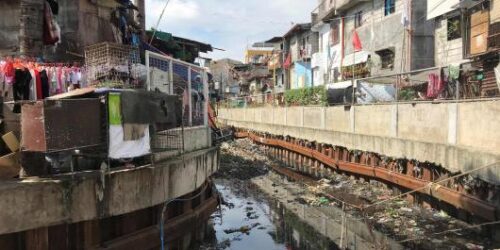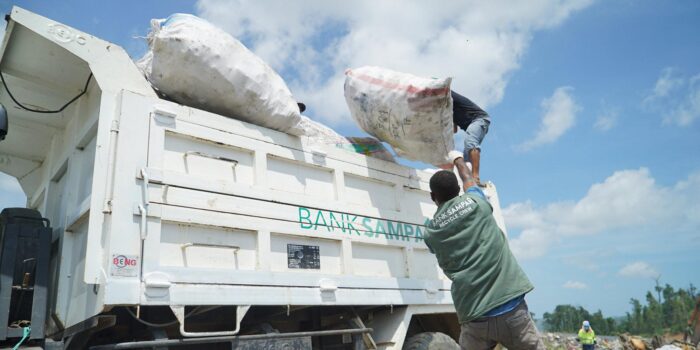Plastic is a Climate Issue, Too

A wide range of environmental changes threaten development. Of these challenges, climate change and plastic pollution in particular inspire concern and action from governments, scientists, and advocates alike. While it is easy to silo the approaches we take to address plastic pollution and climate change, there are fundamental connections between the two issues that can help international development practitioners understand and approach them in new ways. USAID’s work on ocean plastic pollution operates at the intersection of these related problems, and highlights opportunities for innovation in waste management.
Climate issues and plastic are entwined. As of 2019, about 4-8% of oil consumption around the world was associated with plastics, according to the World Economic Forum. If current consumption trends persist, plastics will account for 20% of oil consumption by 2050. Simultaneously, plastic waste can exacerbate the development challenges posed by climate change. Mismanaged plastic waste clogs drains and destroys infrastructure in places where wastewater and sewage systems are heavily taxed by climate-related flood events.
Climate change and ocean plastics also have thematic parallels. Both plastics and greenhouse gases are persistent pollutants whose environmental impacts persist long after their initial dispersal by humans. This dilemma poses a challenge for decision-making systems that incentivize focus on immediate problems and near-term results.
Furthermore, while macroplastics and extreme climate events are visible manifestations of the plastic and climate problems, additional impacts of both plastic pollution and greenhouse gas emissions often lurk invisibly in the background of our lives, whether in the form of micro- and nanoplastics in our water supply or shifting seasonal patterns. It can be particularly difficult to identify and deter these hard-to-see long-term effects, such as health consequences from air pollution or micro- and nano plastic ingestion.
Fortunately, some plastic-oriented solutions can also contribute to climate mitigation efforts. By addressing infrastructure issues created by discarded macroplastics, for example, countries can mitigate consequences from the climate crises. Because of the common properties and joint challenges between plastic and climate, thoughtful action on plastic issues has the potential to generate essential emissions-reducing co-benefits.
With its ocean plastics programming, USAID is working to tackle ocean plastics at the system-level, in ways that recognize the intersections between plastics and climate change. One major focus of USAID’s ocean plastics programs is the “3 Rs”, which you might remember from school: reduce, reuse, and recycle. But rather than focusing on individual iterations of these habits, USAID is devoted to building the structures necessary to implement a 3 Rs mentality at the local and national level. Clare Romanik, a Senior Urban Specialist and Ocean Plastics Specialist at USAID, explained the importance of expanding our consideration of the 3Rs from the individual to the institutional:
“The 3 Rs are consumer behavior, but also business behavior. How are restaurants, vendors, hotels, contributing to excessive waste generation?” Addressing patterns of consumption and pollution among industrial actors is similarly essential to strong climate solutions, and based on the connection between plastics and emissions. USAID’s work to address business’ plastic use in developing nations will have climate co-benefits.

Credit: Misool Foundation
Romanik also stresses the fundamental link between ocean health and the economic wellbeing of developing coastal nations. “The communities that live on the coast are dependent on the ocean for their livelihood,” she said. “Having healthy seas is really important. Keeping the plastic out of the ocean and out of the fish is essential, and in many places, the tourism industry is also at risk, as well as delicate ecosystems like the mangroves.” This focus on both economic wellbeing and ecosystem health aligns with USAID’s climate projects in coastal nations, which often also work to boost local economies and protect natural communities. Simultaneously, if ecosystems and tourist revenue are protected from ocean plastics, they are likely to be more resilient in the face of additional challenges posed by climate change.
Just as climate change invites innovation in policy and technology, plastic may also provide opportunities to think big. The serious impacts of plastic pollution should spark efforts on the part of governments and the scientific community to produce more sustainable alternatives and disrupt the current single-use lifecycle plastic. USAID’s Clean Cities, Blue Oceans project (CCBO) is a 5-year endeavor in Asia, Latin America, and the Caribbean focused on stemming the flow of ocean plastic pollution at its source: rapidly urbanizing coastal areas.
CCBO focuses many of its efforts on improving recycling infrastructure in developing nations, so that plastic can be used without severe consequences for consumers and marine ecosystems. Ultimately, these interventions carry potential climate co-benefits, whether by alleviating infrastructural stress in nations threatened by climate change, reducing emissions caused by plastic production, or improving the health of economically important climate-threatened coastal ecosystems. Romanik, who is a leader at CCBO, explains that plastic can be an important technology for developing nations. “We’re not trying to eliminate all plastic,” she said. Instead, CCBO is asking, “How can plastic be incorporated into a circular lifestyle?”
There is no fighting plastic without confronting climate change, and vice versa. USAID’s work on ocean plastics is powerful because it operates at the system level, and the policy and scientific infrastructure it is building complement USAID climate efforts.
This blog originally appeared on Climatelinks.

